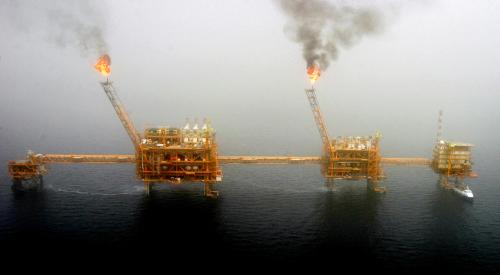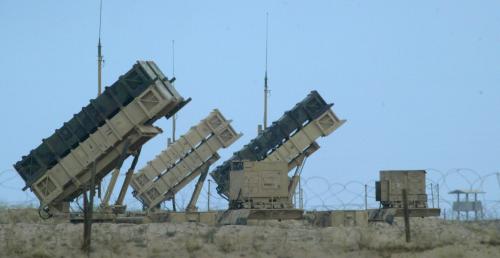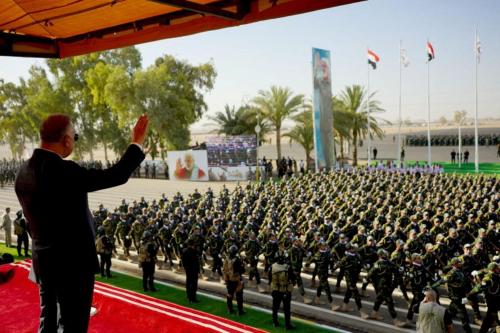Pressure on the Iranian regime is steadily mounting. Following the recent collapse of Iran’s currency, the rial—which ignited widespread demonstrations across the country and brought commerce in Tehran’s Grand Bazaar to a halt—and creeping U.S. sanctions following America’s abrogation of the Iran nuclear deal (Joint Comprehensive Plan of Action, or JCPOA), which in turn caused the cancellation of numerous contracts between Iran and the European Union, Iranians are expressing increasingly widespread and vitriolic anti-regime sentiment.
While the regime faces a significant challenge, it is premature and misguided to claim that Iranians are moving towards regime change. For reasons we outline below, it is safe to assume that despite the apparent stresses to the system and apparent increasing distress in the halls of power, the regime is in no immediate danger, and in the short term, the room to maneuver remains.
Mounting Pressure Points
Protests in Iran were always a fundamental part of Iranian political culture, which the regime reluctantly accepts to release internal pressure. Yet, several unique components distinguish the recent series of protests in Iran, which peaked in December 2017 and January 2018, with no likelihood of waning.
Both their geographic and social scope is significant: The protests include the religious strongholds of Qom and Mashhad, and have brought more merchants (a traditional bastion of conservative, pro-regime support) to the streets, shutting down the stalls of the Grand Bazaar in Tehran to go on strike on June 25. In solidarity, the Bazaaris of Arak, Isfahan, and Kermanshah shuttered their stalls, while protesters clashed with police in the streets of Tehran. The use of extreme, revolutionary slogans was another new and very significant phenomenon, such as “Capitalist mullahs, give us our money back” and even slogans denouncing the Supreme Leader.
The underlying cause for the protests is the growing economic pressure. On the black market, one dollar can be exchanged for 90,000 rial (versus 43,000 in December 2017), despite government efforts to stabilize the exchange rate. But the falling currency rate is merely a symptom of a structurally weak Iranian economy: Corruption, a sick banking system, bureaucratic inefficiencies, and the grip of the Iranian Revolutionary Guard (IRGC) and religious foundations over the economy all significantly restrain the government’s ability to address the people’s grievances around inflation and unemployment.
President Trump’s May decision to withdraw the United States from the JCPOA and renew sanctions on Iran has caused a first-order negative effect on oil exports—in the annulment of a few potential mega contracts—as well as a drop in expected foreign investments. From the Iranian perspective, the future of Western (specifically European) investment becomes gloomier by the day, with the U.S. Treasury determined to apply secondary sanctions as our colleague Suzanne Maloney recently elucidated. For many Iranians, the JCPOA represented a bastion of hope for economic change.
The third distinguishing factor of the present crisis is that these protests represent a crisis of expectations, exposing a pernicious and growing lack of trust between poor yet educated middle-class citizens and the government. The protests of this past December and January erupted due to mounting frustrations brought on by disillusionment with the slow pace of economic growth. (Rouhani oversold the rewards the Iranian people would reap following the JCPOA.) This illusion was further shattered on May 12, when Trump announced the annulment—hopes for economic change evaporated, and this crisis of expectations escalated.
The fourth unique characteristic of this present protest movement is the diversity in the protesters’ agendas. Economic woes are felt differently depending on class, profession, and location. In Varzaneh, 500 kilometers south of Tehran, farmers protest water shortages exacerbated by government mismanagement; in Mashhad, creditors lament their lost savings as unlicensed credit institutions and phony businesses go bust; in Isfahan, retired steelworkers claim to not have received full pension payments for the last five years as the government owes more than $35 billion to the Social Security Organization, which has faced numerous difficulties due to repeated and unprecedented government intervention, to name just a few.
But grievances go beyond the economy: Some protestors are concerned with civil rights and religious restrictions, specifically the law requiring women to wear hijabs. These coalesced into what became known as “Girls of the Revolution Street” protests, where several women in Tehran and Isfahan took to the streets, removed their headscarves, and waved them in the air like flags. This civil disobedience exposes the heart of a debate which questions the core identity of the 1979 Islamic revolution, and the disappointed spaces of individual freedoms where many feel Rouhani failed to deliver.
Finally, there’s the issue of Iranian involvement in various Middle East crises—involvement (in Syria or Lebanon, for instance) that carries a heavy price tag. The 2018 budget featured a significant increase in funding to the IRGC (some observers project a near-40 percent increase, representing almost two-thirds of the defense budget). While reliable data is difficult to obtain, the public has started to ask questions about the regime’s foreign policy and defense decisions, and until economic relief comes, expect such questions to continue. Nonetheless, while these grievances grab headlines abroad, they remain, at least for the present, of negligible importance in the internal crisis.
The failure of symbolic stopgaps
In the past, the regime usually corrected economic problems with quick fixes that rarely solved the problem, but helped assuage the worst of the public’s anger. This is part and parcel of the underlying structural problems of the Iranian economy—so many of them were never systematically addressed, because thorny ideological and political obstacles stood in the way. Expedient, superficial fixes can only work for so long. In an economy battered by a decade-long sanctions regime, plus deeply embedded corruption, it appears the regime is out of tricks. (In the past, some level of corruption was necessary to maneuver around the sanctions, while also being used as a cover for personal benefits. Similarly, some degree of it will become necessary again for the same reason).
Substantial reform efforts have little political feasibility, as they demand deep cuts to budgets that belong to very powerful organizations and agencies—the IRGC, at the top of the list, as well as various religious funds. It will also upset many key political figures who personally benefit from the current system. Such reforms are thus highly implausible, even were they to come as directives from the supreme leader himself. There is no indication that the present government has the desire or ability to move in that direction.
The same applies to the other main axis of protests—personal freedom and human rights. Here too, it seems, the regime cannot turn a blind eye or provide a symbolic concession as it was accustomed to doing in the past. Citizens already frustrated by their lack of personal freedoms are further incited as the regime regularly blocks the internet and popular social media platforms to curtail dissent and deprive the demonstrators of means to mobilize. While in the realm of women’s rights, giving in to demands not to require a hijab in public is too costly, as it touches the very core of the regime’s ideology.
As a result of these realities, the government’s leeway is limited.
Strengthening hardliners
Nonetheless, there is still room for the regime to ensure the protests don’t spin out of control. External pressure—particularly from America and its allies—has always rallied Iranians around the flag. Iranians are adamant that they continue to honor the JCPOA, and hence felt betrayed by Washington’s accusations to the contrary. The regime is very capable of nurturing this nationalistic sentiment and using it as a scapegoat for unrelated problems.
To this point, President Rouhani has delivered some aggressive speeches recently. The Quds Forces commander Qassem Suleimani, the president’s main political rival, praised Rouhani for his tough stance against Washington for its re-imposition of sanctions on Iranian oil exports. On July 21, Rouhani threatened the United States even more aggressively, for similar internal reasons. While the threats can certainly indicate rising pressure from Tehran, they also demonstrate a high level of cohesion among the Iranian leadership.
Beyond the heightened rhetoric, the regime would not hesitate to use brute force and wide-scale domestic repression, including through the IRGC-commanded paramilitary Basij force, which has played a major role in suppressing demonstrators before. However, in the past, the Basij showed reluctance to using lethal force against protests—a phenomena which was corrected by the IRGC following the 2009 unrest, through structural, personnel and tactical reforms. The IRGC and Basij force are heavily invested in the regime’s ideology and political identity—more so than the police or the military—and hence serve as a highly loyal regime tool.
When will the regime be challenged?
Despite the significant growing internal pressure in Iran, with protests presenting a bigger challenge than before, it doesn’t appear as if the regime faces an existential threat. The protests are still missing essential elements, which observers should watch as indicators about where this is heading:
Leadership. The present protests lack an organized, centralized leadership. It is organized locally, with no overarching strategy, organization, or communication. This, of course, is due to the regime’s efficient efforts at preventing such coordination.
A clear agenda. The diversity of issues on the protesters’ agenda makes it challenging for the regime to properly address the complaints. At the same time, this diversity prevents the opposition from coalescing into unified faction and defining a clear agenda on a national level that may be able to mobilize larger numbers of participants.
Masses. Following the Arab Spring and its catastrophic results in Syria, Libya, and Egypt, as well as the blow the Iranian opposition suffered in 2009, the political appetite for a full-scale revolt in Iran is low. Generally speaking, the protests are more inclined towards gradual change through soft, non-violent protests rather than using extreme violence towards revolutionary changes. Therefore, without a very strong and clear agenda, and leadership that may provide hope for success, the risk-averse masses are going to stay home even if they hold heavy grievances against the regime.
Law enforcement’s response. One of the common denominators of the Arab Spring was that in order to successfully shake regimes, protestors had to have at least tacit, partial cooperation with a relevant law enforcement branch. The military, and in some cases the police, refusing to open fire on demonstrators in Tunisia, Syria, and Egypt played a major role in challenging the respective regimes by denying them a crucial tool for repression. Unlike these cases, in Iran the IRGC and especially the Basij know that they cannot separate their fortune from the regime, even if they desired (which they don’t). Therefore there is no reason to expect such a scenario at the moment. This might change if the protests’ momentum significantly grows, therefore changing the Basij’s risk calculation.
Regime’s leadership cohesion. For now, the Iranian regime seems to be cohesive, despite traditional rivalries and differences in political stances. Unity may be threatened in the face of mounting pressure if the protests’ momentum increases, and especially if that happens during political transition (for example, if Khamenei were to die and a new Supreme Leader were chosen). It’s difficult to predict the medium or long term: While there is little doubt that the regime is in serious distress in face of these structural, unsolved problems, it will probably continue to get by with increased use of oppression and currency reserves, at least unless or until the factors above converge.
Overall, there is little doubt that the internal pressure of a sustained protest movement in Iran presents a massive challenge to the regime—pressure that is exacerbated by external sanctions. But the regime’s survival is not yet threatened, and as long as the protest movement lacks the above-mentioned elements, the status quo will remain for foreseeable future.






Commentary
Iran’s dire, yet (for now) navigable straits
July 25, 2018